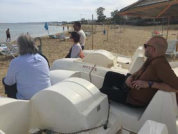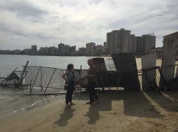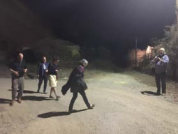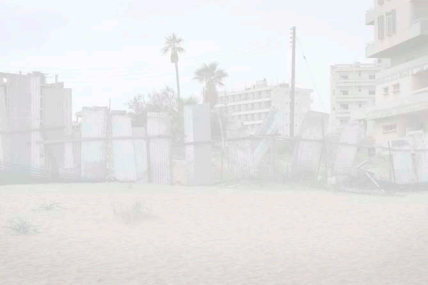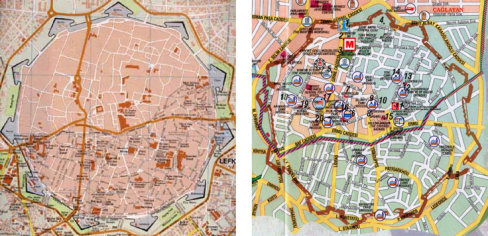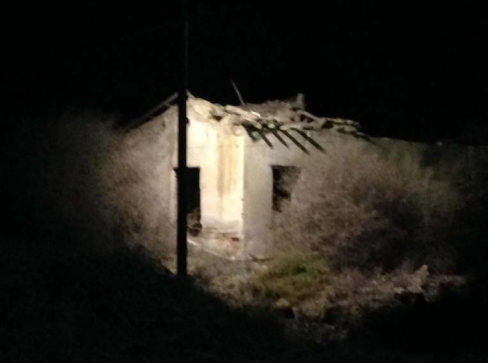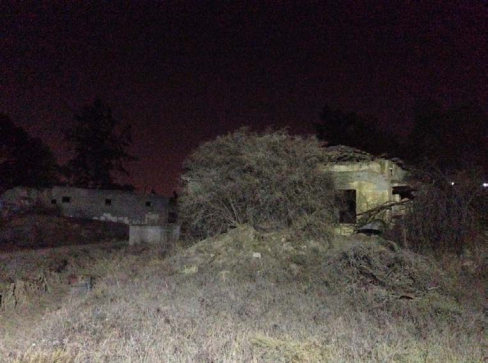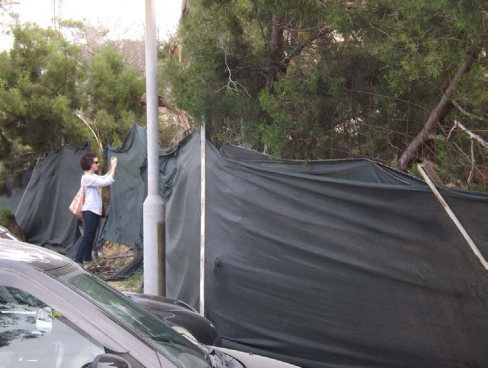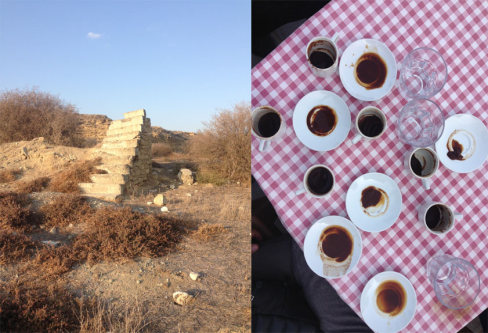‘My-places’ were used to imagine and utter stories that happened or did not, over the fortune telling with the traditional Cypriot-Turkish Cypriot-Greek Cypriot-Turkish- Greek coffee. They offered opportunities to look into the ‘eyes’ of the ‘other’, maybe as if looking into your own eyes to find out about the stories that were engraved and the ones that are still waiting to be written on ‘my-places’.
Stories of Places (Cyprus)
Authors:
Susan Brind,
Yiorgos Hadjichristou,
Jim Harold,
Duncan Higgins,
Shauna McMullan,
and Ana Souto
(8th May 2017)
Caught in static
Extract - This is how we lived…………..you away from me. In this house, every whisper, smile, thought, laughter and word………it moves, just some little something you found in the corner, hairs, paper, song or a dance.
Extract....here fingers touch too much in places lost and found, they said 2 ways displayed, displaced, this place, this way, no place or even now 2 faced. “Oh disgraced face which direction are you looking”. Well really there is no place to go……..That is what they call it now, “displaced face” looking in many directions this side and that.
Extract - A strange new language hard to understand, not a familiar tongue, mixed with high and low words hard to digest. Words with no destination.
Little things coming through the cracks, like clouds separate….lost some place or other, lost with wild dogs. Some place sooner or later, someplace. Somewhere or other?
Out of this place or other. Gone. Going somewhere or other. Never here or there ever.
Ok?
Not familiar or ever touching or smelling familiar. Gone.
Gone away.
Ideas Northwards.
Extract - No sunlight, no light, loose, the meadows, trees towering, semi sleep darkness.
…………………….future, past or present. Leave and then retrieve still in another place. Light and sounds, it holds some small things between us, is it an impossible crossing.
The sound of the blue walls, the sound of the house moving in the wind, the sounds of books, candles and electric light, and food cooking, keys and doors. It sounds like: those ever so familiar ticks, creaks, rumbles, hums and the sound of nothing and always that static hum, trapped in static. Then listen to the sound of the bed, fires and the floor. The sound made by
windows moving and that terrible rumble in the wind. When darkness covers the house up to the windows and it makes everything sound soft, tiny musical notes, scales, major or minor that just touch us from somewhere, little echoes, rhythms and rhymes. The sound made by the creak of the path that slopes down to the front door. Water. The sound of time, space and light, the echo of an impossible crossing trapped in static, this is like the light upon the wall.
The progressive disassembling of a person.
(Professor Duncan Higgins)
Does it become easier? Dealing with something so sensitive? Does the pain ever go away?
Do you want it to go away? Toughen up! Is it a good thing? Can anyone really judge?
Do you have a choice? Do we have a choice?
Do I?
Are the memories a good thing? That we are so attached?
If you are not part of it, why would you become part of it?
I have to be part of it, I do not have a choice. I actually do not want to even have that choice, it feels like a responsibility, even though it is not.
Memories are such a terrible thing, they are crude, they can be overwhelming, and at the same time, without them, we cannot be ourselves anymore. We either manipulate memories to make them more palatable, to be able to survive, or simply dismiss them, send them to oblivion.
But those memories, narratives, histories, are ever present, you just need to be prepared to see them, engage with them, feel with them. They might be tangible or intangible, “official” or emotional, they are simply there.
1)On the flight from London to Larnaca I realised for the first time just how close Nicosia is to Aleppo, 224 miles by air, 369 miles by land.
2)Standing on the balcony of the Nicosia Master Plan office you look straight onto a vast Turkish flag drawn on the face of the mountain overlooking Nicosia. It’s visible from lots of places throughout the city but in particular in the hours of darkness when a second moon and star are illuminated.
3)There’s a set of steps, isolated from any other architectural feature, rising out of the dry earth, surrounded by open views in the deserted village of Agios Sozomenos. The date 14/9/1959 has been inscribed by hand in what was wet plaster, on the second step up from the ground.*
4)In the car journey from Nicosia to Famagusta (Gazimagusa), Yiorgos re- told the story of his family’s exile from his mother’s village Engomi (Tuzla in Turkish), a site of Bronze Age settlement, once called Alasia. He remembered the exact time and date of their departure, 15th August 1974.*
5)On a, soft, white, sandy beach in Famagusta, empty, bombed-out buildings provide the backdrop for holidaymakers and sunbathers. A ramshackle, buckled, low, metal, fence separates us from the Forbidden Zone, drawing a dividing line over the sand, down into the clear blue sea.
6)We laughed for forty-five minutes, belly aching laughter, whilst having our future read in a Café next to the beach at Famagusta. Leaving behind seven cups and saucers on a red and white gingham tablecloth, each containing the residue of our coffee and the key to our future.
7)A soft, green, see-through, torn, draping, mesh, net defines and denies areas of the city.
8)Walking along the edge of the ghost city we listened to roars and cheers spilling out from the Athletic Association of Gazimagusa Stadium as a penalty was taken in a game between two teams we didn’t know.*
9)The white lines woven into the red carpet in The Selimiye Mosque, once the Cathedral of Saint Sophia in North Nicosia, run at a 45 degree angle to the architecture, orientating the mosque towards Mecca and making everything inside seem at a slight slant.*
10)Maria, Angela and their students spoke about how the material from destroyed, collapsed and bombed buildings has the potential to create new ground, and as a consequence new topographies.
11)Sharing Yiorgos’s Kukicha, Japanese twig tea I was reminded of the present Tanya gave me 10 years ago, in Glasgow, of the same tea. I realize now that I never knew how to brew it properly.
12)Driving back in the pitch dark, from Famagusta to Larnaca, taking Duncan to the airport, we couldn’t find the checkpoint. Three dead ends, before we got through.*
13)I finished the last page of Rebecca Solnit’s A Book of Migrations8 as the plane touched down in London at 16.05pm on Sunday 13th Nov.
Enroute: Somewhere above SouthernEurope.
• Our seat companion on this flight turned out to be a middle-aged Greek Cypriot man returning home to the Larnaca area after visiting his children in London. He was originally from Famagusta (Gazimagusa), but post the Turkish Invasion of 1974 his family – he was just a child at the time – were among those displaced/relocated to the South. He later moved to London, where he worked as a musician playing Latin American dance music. He had children (who have stayed in London), while he and his wife have returned home: not to Famagusta but to Larnaca. When he can, he travels back to London. His heart is continuallysplit...
Nicosia: 35.1029ºN 33.2141ºE 36SWD.329109248210
• Lefkosia and Lefkosha – Greek and Turkish transliterations,respectively.
• Navigating around both parts of the Old Venetian City requires two maps, each detailing one side of the line or theother.
Each map leaving the other (side) as if it were an elusive half memory of the other (half) – a kind of limit to reliable information – each becoming the near ghost-like rendering of a place set beside that which is material, named (and apparentlyreal).
Moving from one map to the other leaves one momentarily in a liminal space between nations, between times, and outside of any signification that might be provided by any one of the two State’s maps.
• A one-hour time difference exists between the Turkish Republic of North Cyprus (TRNC) and the Republic ofCyprus.
But how many degrees difference lie between their spiritual Easts? An arc between 90ºE to 155.99ºE?
Alexander the GreatSt. 35.1024ºN 33.2131ºE 36SWD3266992323
• A house with a small inset carved stone plaque, eroded and barely legible, but in Arabicscript.
• Close by a shop window with a faded poster: “Life in the Spirit Fellowship KKM CyprusChapter”.
OmeriyeMosque 35.171ºN 33.365ºE 36SWD3328992169
Walking with a member of the Nicosia Master Plan we were told that in the wake of the generations of troubles, just across the water in Lebanon, Israel, Palestine and Syria, the Omeriye Mosque Area had become host to many immigrants from those countries. According to City records the character of the area has changed, and some tensions have lingered. The mosque, originally the fourteenth century church of St. Mary, was part destroyed and later dedicated to the Muslim Prophet Omer after the Ottoman invasion in 1570. Now, once again, it seems it has a congregation.
LedraPalace 35.1043ºN 33.2119ºE 36SWD3236792913
• Coffee at the House for Co-operation between the North and the South.In the gathering dusk we entered the liminal world of the coffee drinker: a world where snatched and partial phrases – some understood, some not – randomised half glimpsed sights, and the meanderings of thought all seemed to swirl and blend with the dark, bitter sweet, flavour of coffee. This was a melancholy place/non-place, set in a hinterland realm where certainty and meaning became relative terms: both a place of life that might be written or spoken of, and a place shadowed by a sense of an unaccountablemourning.
• US Election party in the Buffer Zone – fairy lights and star-spangled- banner-bunting. There for one night only to celebrate American election day… gone in the morning with the news of Trump’svictory.
LedrasStreet 35.1029ºN 33.2141ºE 36SWD3290992487
• We crossed into the North at the Ledras Street border-crossing … between the two passport control points that were no more than a hundred metres apart. The route between the South and the North is along a portion of Ledras Street that was, for forty years, cut by the Buffer Zone (Dead Zone) and had become ruinous in appearance. The modern restored street is, however, only cosmetic and made up of façades only; it has become a theatrical backdrop to the passage of locals andtourists.
• On diametrically opposite sides of Ledras Street and either side of the border, lay the woodworking areas of the two cities, one restored the other still run-down. The qualities that they shared, however, were the warm smell of timber, the haze of wood dust that filled the air and the sometimes dissonant, sometimes harmonic sounds of the artisans’ circular saws, all mingling together in the dereliction of the BufferZone.
IdadiSokak,Lefkosha 35.177ºN 33.364ºE 36SWD3310492759
In the small tired confusion of streets behind the Lusignan Cathedral of St. Sophia, now the Selimiye Cami (Mosque), is the small shop window of an old Turkish photographer’s studio. Among the chaos of photographs of Northern politicians – Rauf Denktash key among them – actors, singers, and other memorabilia, there are still the curious celebratory, but faded, portraits of young Turkish soldiers. The ageing images suspend their youthful faces in time. Studio posed, they are superimposed onto the outline of Cyprus – the ’babyland’ to the Turkish ‘motherland’.11
AttaturkSq,Lefkosha 35.178ºN 33.360ºE 36SWD3285992855
• We are sitting at a busy café in the North of the City, in Attaturk Square – known locally as the Saray Square. The café is set in a large paved area and acts as a hub for the city. All of the tables are take up by a mix of locals (who sit and chat for a long time over coffees) and tourists (who stay just long enough to drink, eat and move on). The Square’s bustle contrastswith
11 Papadakis, Yiannis, Echoes from the Dead Zone, London & New York: IB Tauris, 2005, 21.
the way things were the last time we were here in 2005. So, too, does the café’s position. There has been a slight adjustment of a few hundred metres to its location. It has migrated northwards from just outside the front doors of the inelegant 1960’s built, Saray Hotel and a patch of shade, towards the relic of the carved Venetian Column (moved here from Salamis in 1489 by the Venetians). It is also opposite the former British Courthouse: still in use today – evidenced by the queues that form and disperse on the steps to the building.
Looking back towards the café’s former location, now deserted, it is hard to image how it was here in 2005. There were very few people then, locals in the main: a small gathering of men (mostly cab drivers, whose taxi rank stood nearby) who sat within an enclave formed by a small huddle of tables set up underneath the trees. Occasional bursts of activity jarred this somnolent world of newspapers and coffee in the form of gangs of Anatolian children – the immigrant children of families sent to colonise the North (not always happily and often bemused by their new reality) – who hustled for scraps of food, small amounts of cash or fought amongst themselves.
• Night time … just within the Buffer Zone with our architect guide and his small Cyprus Poodle (straining at theleash)...
... silent earth, silent dwellings, disturbed by the occasional footfall of a soldier.
• A Greek Cypriot National Guardsman challenges us as we walked in the Buffer Zone (DeadZone).
“Its dangerous to go further into the Dead Zone!” “Why? Because of snakes or mines?”
“No. Because it is the Dead Zone!”
Nekros (as in the dead body/the corpse) the only word we could understand
– a name ricocheting back from the past – the name adopted by a sad romantic nihilist student, about the age of this Cypriot National Guardsman. He was the friend of a friend and would, if still alive, be in his sixties now.
dead zone dead man
we kept walking (retraced our steps)
• We retreated to the security of our friend’s home. It is a place with fluid walls and deep pink Bougainvillea waterfalls in each courtyard: private and public space intermingling, and permeating eachother.
• A student project set by Maria and Angela, and a morning’s discussion with their students has aimed us at this place: not so remote, but drifting further and further away in terms of memory – and history. Agios Sozomenos, the location, under limestone cliffs, was once chosen by an ascetic monk for his otherworldly retreat; then became a place of pilgrimage; a village; and, since 1964, a dissolvingruin.
• Buildings without walls – or with the vestiges of walls – litter the landscape; their windows and doors emptyslots.
• Film: A Detail in Cyprus by Panicos Chrysanthou (1986) tells of a woman and her daughter visiting the ruined village. Ex-villagers, Greekand
Turkish Cypriots, come to meet them and recount their personal stories of war (the inter-communal strife of 1964)12.
• The dry sound of the land … and the vocalization of actors for a period drama. The village’s ruined basilica once more the setting for a film to come.
• Approximate current population in Agios Sozomenos –4.
• Adobe, eroding back to the earth … Silent earth, silent dwellings ... becominghistory.
Famagusta/Varosha: 35.7364ºN 33.5729ºE 36SWD8731786513
• Known in Greek as Ammochostos (Αμμόχωστος), meaning hidden in [the] sand.
Meeting
Meeting with friends from far away Meeting with myself
Here
In my place Place?
First at the university - a dilapidated shoe factory that was ‘reborn’ into the Architecture Department – in a derelict area as a result of the divided capital
Later at my house - an attempt to deal with a traditional house literally cut in the middle - a way to heal the truncated traditional, courtyard spatial organization - a challenge to regenerate the amputated original ‘milieu’- a response to the adjacent ‘dead zone’, the porous border, the ‘green line’
Then in my home town - the ghost beauty that is waiting – and - waiting to get its life back- where my childhood memories are kept away from me.
We met in my country, a small island, even smaller looking at it from both of its divided sides. In all these ‘my-places’ we worked and rested, talked and listened, walked and sat, laughed and smiled, ate and drank. We scripted new stories on their palimpsest-like materiality. We created ephemeral, momentary human landscapes over the tables, the paths, the interiors of the buildings.
• On the demarcation line of the Buffer Zone, where the public beach meets the military limit, and where the sand meets the sea, an unidentified bird perched. With a kingfisher-like shape and bill, but predominantly black, with a white back-stripe, it may have been a Smyrna Kingfisher(Halcyonsmyrnensis smyrnensis) – “a very rare vagrant”13 – but could also have been a Black Tern (Chlidonias nigra nigra); another migrant.
• A plain clothed Turkish Cypriot policeman – our temporary shadow on the beach, wearing immaculate black sports clothes and white trainers – leaned in to listen our conversation. Apparently observing that as international visitors we posed no threat, he disappeared as discreetly as he hadappeared.
• ACafe,Gazimagusa 35,125ºN 33.943ºE 36SWD8600087413 Sitting here at the Patek Café, right by the Venetian City walls, thinking of the caged birds at the café’s doorway, we realized we had been here before: when Beirut had come under attack and refugee ships were crossing the sea towards the relative safety of Cyprus. The City walls fifteen-metres high, whilst not blocking the sunlight, obscured any view of the harbour, the disembarking refugee ships and the open sea that lay between us and the Lebanon. With both the view and the horizon lost to us we seemed to be suspended in a timeless world; one without a vanishing point, where the intense sunlight and the heat conspired with the ancient stones and azure sky to flatten space, and to render time and history into something unknowable.
(Susan Brind & Dr. Jim Harold)
BIOGRAPHIES
Susan Brind is an artist and Reader in Contemporary Art: Practice & Events, Dept of Sculpture & Environmental Art, School of Fine Art, Glasgow School of Art, Glasgow, Scotland.
Professor Yiorgos Hadjichristou is an architect and Professor at the School of Architecture (ARC), University of Nicosia, Republic of Cyprus.
Dr Jim Harold is an artist, writer and visiting-lecturer to the Department of Sculpture & Environmental Art, the M.Litt Fine Art Practice and Art & Critical Theory, School of Fine Art, Glasgow School of Art, Glasgow, Scotland.
Professor Duncan Higgins is an artist and a Professor both at the School of Art & Design, Nottingham Trent University, Nottingham, UK, and the University of Bergen, Norway (formerly Bergen Academy of Art & Design).
Shauna McMullan is an artist and part-time Lecturer in the Department of Sculpture & Environmental Art, School of Fine Art, Glasgow School of Art, Glasgow, Scotland.
Dr Ana Souto is a researcher and Senior Lecturer in the School of Architecture, Design & the Built Environment, Nottingham Trent University, Nottingham, UK.
Towards the end of his short life the poet-wanderer, Arthur Rimbaud, came to Larnaca “...not knowing in which direction [he’d] be made to turn.”9 – and briefly found contracting work in an area he described as a desert. He wrote no poems (that period was gone); just a few letters and then he moved on to Aden and work as an agent for a coffee merchant.
• 12th November 2016: Leonard Cohen died today, or at least we heard the news that evening. He actually died on 7th November as we arrived in Nicosia in the dark. On his last record he had sung ‘you want it darker’ – intoned in his half-song, half-speaking, style. As we looked down into the surface of our freshly-made coffees, it was as if we could all hear his voice. We gazed through the café door into the night-time street and breathed in, deep and long, the mixed smells of the Old City and the soft aromas of the red blossomed Oleanders.
9 Rimbaud, Arthur, Selected Poems and Letters, Jeremy Harding & John Sturrock (eds/trans), London: Penguin, 270.
12 Http://www.artimagescyprus.com and http://www.vimeo.com Ayios Sozomenos Ver 1 [both accessed 5/1/17].
13 Bannerman, David A. and W. Mary Bannerman, Birds of Cyprus, Nicosia: K. Rustem & Brother, 1989, 173.
* Notes made in the edges of the pages to be followed up include:
i) Swift’s Gulliver’sTravels;
ii) a pygmy elephant skull in the Natural History Museum,Dublin;
iii) Sir Roger Casement’s Peruvianbutterfly;
iv) John O’Donohue, priest, poet and author of Stone as the Tabernacle ofMemory;
v) Joyce’s trees, the elm and theash;
vi) the imprint of St. Brigid’s knees in stone at The BlessedBush;
vii) the myth of ‘The Destruction of Da Derga’sHostel’;
viii) Letters to a Blackbird by MichaelDavitt;
ix) St Brendan,The Parish of the Travelling People, Cook Street, Dublin;and
x) FreyaStark.

